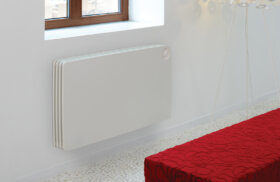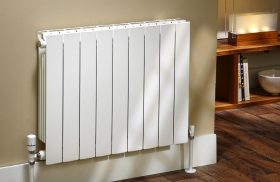Modern radiators can be placed anywhere and still have high energy efficiency. Our horizontal designer radiators offer an ideal form of central heating while being a statement piece.
Whether you’re looking for a compact radiator, a traditional cast iron radiator or the best radiator for your living space, we’ll help you to decide on one to suit your room style.
Types of Horizontal Radiators
Panel Radiators
Panel radiators consist of multiple panels with convector fins in between. They are a popular and versatile choice, providing efficient heat distribution. However, they can be bulky and may take up more wall space compared to other types.
Panel radiators are the best radiators for most room styles and sizes due to their versatility. They work well in both modern and traditional interiors. However, in smaller rooms where space is limited, slimmer options like flat panel radiators might be more suitable.
Column Radiators
Column radiators feature vertical columns or tubes connected horizontally. They exhibit a classic and timeless appearance, have excellent heat output and have a durable construction. They can be relatively bulky, take up more wall space and have a higher cost compared to some other types.
A column radiator is ideal for traditional or period-style rooms, adding a touch of elegance. They work well in larger spaces where their size and presence can be appreciated. In smaller rooms, a horizontal column radiator can provide a stylish focal point.
Flat Panel Radiators
Flat panel radiators are characterised by a slim profile and clean lines. They have a sleek and modern design, are space-efficient, have a quick heat-up time and good heat output. However, they have a limited heat convection compared to panel or column radiators and may not be suitable for rooms with high heat requirements.
Flat panel radiators are perfect for contemporary and minimalist interiors as their sleek design complements modern aesthetics. They are ideal for smaller rooms or spaces where wall space is limited.
Designer Radiators
Designer radiators are created by renowned designers, and they prioritise both functionality and aesthetics. They have unique and eye-catching designs and can be a statement piece in a room, however, designer radiators do have a higher cost compared to standard radiators.
Designer radiators are highly versatile and suitable for various room styles, depending on the specific design. They are particularly well-suited for contemporary, eclectic, or design-focused interiors and work well in living areas and kitchens.
Low-Level Radiators
Low-level radiators are specifically designed to be installed close to the floor. These radiators help counteract cold downdraughts and prevent condensation on windows. While they are suitable for rooms with large windows or limited wall space, they may not provide sufficient heat output for larger rooms.
Low-level radiators work well in spaces like conservatories, bathrooms, or rooms with limited wall space. However, in larger rooms, additional heating sources might be required.
Factors to Consider When Choosing a Horizontal Radiator
Room Size and Wall Space
Measure the available wall space where the radiator will be installed. Consider the dimensions of the radiator and ensure it fits within the allocated space.
Additionally, in smaller rooms, opt for radiators with slimmer profiles to maximise floor and wall space. For standard sized and large rooms, double panel radiators are by far the most efficient.
Room Style and Aesthetics
Consider the overall style and aesthetics of the room. Choose a radiator that complements the existing decor in your space. For traditional interiors, column radiators might be a suitable choice, while modern interiors might benefit from sleek and minimalist designs like flat panel radiators or designer radiators.
Material
From steel radiators to cast iron and aluminium radiators, radiators come in various materials. Each material has different heat-conducting properties and visual characteristics. Consider the durability, maintenance requirements, and visual appeal of the chosen material and finish.
Heat Output
Assess the heating requirements of the room in British Thermal Units (BTUs) where the radiator will be installed. The higher the BTU rating of a unit, the higher the heat output.
Consider factors such as room size, insulation, and the number of windows. It’s hugely important to make sure the size of each radiator provides a high heat output for each room.
The Best Horizontal Radiators for Different Room Styles
Traditional Room
A column radiator with a classic cast iron design will work well. These cast iron radiators complement the traditional aesthetic with their elegant columns and ornate details.
Modern Room
With its sleek and minimalist design, a designer flat panel radiator will complement a modern room. This radiator combines functionality with contemporary aesthetics, featuring clean lines and a slim profile.
Minimalist Room
A flat panel radiator with a matte white or black finish has a minimalistic appeal. This radiator blends seamlessly into a minimalist space, offering a simple and understated appearance.
Installation Tips
Installing a horizontal radiator requires attention to detail and following proper procedures to ensure safe and efficient operation. Here are some safety precautions to take:
-
Electrical Safety
Ensure the radiator is installed according to electrical safety regulations and standards. Make sure the central heating system is switched off before installation.
If the radiator requires electrical connections, such as for electric heating elements, consult a qualified electrician to ensure proper installation.
-
Secure Mounting
Use appropriate wall fixings and ensure the radiator is securely mounted to the wall to prevent accidents or damage.
-
Hot Surface
Radiators are a heating system that can become hot during operation so take precautions to prevent accidental contact, especially if there are children or vulnerable individuals in the vicinity. Consider installing radiator covers or using safety gates if necessary.
-
Regular Maintenance
Regularly inspect the radiator for any signs of damage, leaks, or corrosion. Address any issues promptly to maintain safe and efficient operation. Follow the manufacturer’s guidelines for routine maintenance, such as cleaning and checking for air pockets.
Choosing the right horizontal radiator for your room is crucial for both comfort and aesthetics. By carefully considering these factors and recommendations, you can choose a horizontal radiator that meets your heating needs, complements your room’s style, and provides long-lasting performance and comfort.
Visit one of our radiator showrooms near you to see our horizontal radiators on display and speak to an expert about your heating needs.
St Albans | Brighton | Islington | Clapham | Leamington Spa | Bristol





